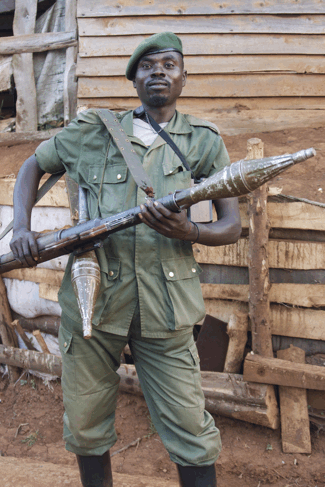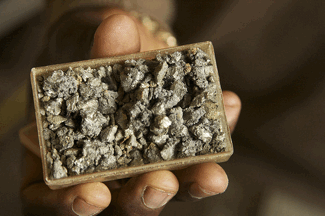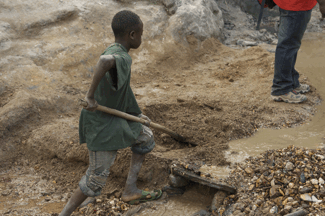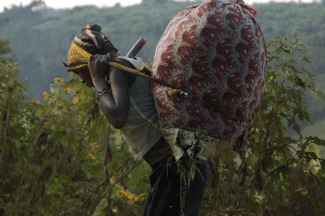Blood Minerals Fuel Congo Conflict
Air Date: Week of February 12, 2010

Armed groups control the majority of gold and minerals mines in eastern Congo, where villagers are forced to work as laborers. (Photo: Lezhnev/Grassroots Reconciliation Group)
High-tech gadgets like smart phones, mp3 players and laptops don't just offer constant connectivity and instant entertainment, they also link American consumers to the deadliest conflict in the world. David Sullivan of the Enough Project tells host Jeff Young that the global demand for minerals like gold and tantalum, essential to portable electronics, provides millions of dollars to violent groups competing for control of lucrative mines in the eastern Congo.
Transcript
YOUNG: The Democratic Republic of Congo in central Africa generates some of the world’s most shocking statistics. A decade of war claimed at least five and a half million people – the deadliest conflict since World War II. And more than a thousand still die each day from factional violence. More than a million people were forced from their homes in Congo just last year and it’s been called the most dangerous place in the world to be a woman – one in three has been raped. Now, I'm reading these statistics from a text on my handheld, my smart phone – this thing –
[DIGITAL CELLPHONE RINGTONE]
YOUNG: Which could also have a connection to Congo’s violence, according to David Sullivan. He’s with the Enough Project, a Washington, D.C.-based group that’s drawing attention to what Sullivan calls “blood minerals”. David, what’s in this phone of mine that might be from the Eastern Congo?

Tin ore: one of the minerals that lie at the heart of American cell phones, and at the heart of violent conflict in eastern Congo. (Photo: Sasha Lezhnev/Grassroots Reconciliation Group)
SULLIVAN: Well there's what we call the three Ts: tin, tantalum and tungsten, as well as gold. Tantalum, which in Africa is called coaltan, that’s the mineral ore, is used in something called capacitors, which are crucial to storing energy, and so are very necessary for any sort of portable electronic device.
Then you have tin. Tin is actually used as the solder, which affixes components to the circuit board of the phone. Tungsten, in particular with cell phones, it’s actually used for the vibration alert – gives the phone the capacity to vibrate. And then, gold used as a connector in various electronic products.
YOUNG: And why does so much of this stuff come from this particular spot on the planet, the Eastern Congo?

This 15-year-old boy has been working in this gold mine in eastern Congo since he was eight. (Photo: Lezhnev/Grassroots Reconciliation Group)
SULLIVAN: Well, you can get this stuff from lot’s of other parts of the world, but when it’s mined by rebel groups--often times using forced labor under pretty tough conditions--it’s cheap. And so what we hear from sources within the industry is that these minerals coming out of Eastern Congo and central Africa can be half the price of stuff that is sourced from places like Australia or Brazil, where we know it’s not contributing to conflict.
YOUNG: And this happens to be one of the most violent in the world.
SULLIVAN: Yeah, you know, it’s the deadliest war in the world since World War II. And the minerals play an important role in what is a very complicated conflict. You have sort of an alphabet soup of different rebel groups and militias like the FDLR partly responsible for the genocide in Rwanda, continuing to operate in Eastern Congo where they both control some of these mines and also illegally tax other mines, and are able then to purchase weapons even when other governments and other sources of support have cut off these militias.
And among the worst is actually the Congolese army itself, which although it’s supposed to protect the population there, winds up preying upon the population committing some of the worst atrocities against them. And the Congolese army is also very much involved in the minerals trade; they’ve actually taken control of some mines from the rebels, but then continue to practice the same exploitation of the population. So, you have the worst armed groups on all sides of the conflict continuing to profit from the trade of these minerals.

Armed groups control the majority of gold and minerals mines in eastern Congo, where villagers are forced to work as laborers. (Photo: Lezhnev/Grassroots Reconciliation Group)
YOUNG: And do we know roughly how much money is flowing to these competing groups?
SULLIVAN: Well, my organization, based upon some really rough back-of-the-envelope calculations, we think the order of magnitude of this is approximately 180 million dollars a year.
YOUNG: Well, now that’s a lot of money here, I’m guessing it’s a whole lot of money there. Put that in context for us, say compared to – I don’t know, the average income for someone living and working in the Congo.
SULLIVAN: That’s quite a lot more than that. Congo’s one of the poorest countries in the world. The miners themselves who are engaged in really backbreaking work and abysmal conditions in mines frequently subject to caves and all sorts of social and environmental hazards – they earn about a dollar a day.
YOUNG: So this little handheld I’m looking at right here, this would be equivalent to roughly the annual income of one of those workers?
SULLIVAN: Yes, that’s about right.
YOUNG: So, I’m looking at my phone and now I’m looking at it somewhat guiltily, but I guess I could also look at that and say, “ah ha” here’s my leverage to make things different, right?
SULLIVAN: That’s exactly right, we can use our consumer power to demand from the companies that we purchase from that they change the way they do business, and that they put in place the systems to keep the conflict minerals out of our phones. And that’s going to help contribute to a broader effort to actually resolve the conflict in Eastern Congo.
YOUNG: Yeah, many of us are familiar with conflict-free diamonds where the companies give us some assurance they know the source. Is that the model that you think can be applied to these minerals and the companies that use them?
SULLIVAN: Ultimately, I think that is the model. What we would like to see actually is a kind of shifting of the burden of proof because right now companies cannot tell you with certainty that they are not sourcing minerals from Eastern Congo. They instruct their suppliers not to, but they don’t have the checks and balances in their supply chain to be able to prove that their products do not contain these conflict minerals. And so what we would like to see is for those companies to really verifiably prove to consumers where they do get their minerals from.
YOUNG: So, when you approach companies with that idea, what do they say?

A woman carries a load into town. Aid groups estimate one in three women in eastern Congo have been raped. (Photo: Lezhnev/Grassroots Reconciliation Group)
SULLIVAN: Well, certainly no company wants to be in favor of conflict minerals, but we’ve yet to see the really bold leadership from the industry that’s going to make the difference. You know, companies are still competing based upon price and so to actually be the first to put in place the systems that would actually exclude these minerals from their supply chain, they see that as putting them at a competitive disadvantage.
So, we really need to up the volume around this issue so that companies start to see a demand for these conflict-free goods. And there’s actually been progress on Capitol Hill, both in the Senate and the House of Representatives, legislation has been introduced that would provide for greater transparency in these supply chains.
YOUNG: But has the effort on blood diamonds really worked all that well or are there weaknesses there?
SULLIVAN: In many ways the efforts have been remarkably successful. I think that the attention from consumers and the pressure on industry during the late 90’s and early 2000’s did actually help contribute to resolving very violent wars in Liberia, Sierra Leone and Angola that were very much fueled by diamonds.
Today, there are problems with how that process is working, particularly in the case of Zimbabwe where blood diamonds that are controlled by that country’s army have been slipping into global supply chains and getting around the process that’s been set up to keep those diamonds out of global markets.
YOUNG: You know, it seems that whether it’s diamonds or minerals in our electronics products it’s all sort of part of a bigger story about global consumption, where we the consumers in the developed world really don’t know that much about where our stuff comes from and what is the true cost of giving us this stuff. Do you see that beginning to change at all?
SULLIVAN: I think that there’s certainly a recognition that this issue of conflict goods is just the tip of the iceberg of wider concerns about where the things that we consume actually come from. And you see that whether it’s in terms of people now wanting to know exactly where the food they’re eating comes from and demand for fair trade products, and increasingly recognize that we need to really get to the bottom of these supply chains and ensure that things like child labor, labor rights, and environmental concerns, as well as these human rights concerns – really make a change.
YOUNG: David Sullivan with the Enough Project, telling us about blood minerals. Thank you very much.
SULLIVAN: Thanks a lot.
Watch video by the Enough Porject about the conflict mineral supply chain.
Links
Check out David Sullivan's recent report on the conflict minerals trade "Digging In"
Living on Earth wants to hear from you!
Living on Earth
62 Calef Highway, Suite 212
Lee, NH 03861
Telephone: 617-287-4121
E-mail: comments@loe.org
Newsletter [Click here]
Donate to Living on Earth!
Living on Earth is an independent media program and relies entirely on contributions from listeners and institutions supporting public service. Please donate now to preserve an independent environmental voice.
Newsletter
Living on Earth offers a weekly delivery of the show's rundown to your mailbox. Sign up for our newsletter today!
 Sailors For The Sea: Be the change you want to sea.
Sailors For The Sea: Be the change you want to sea.
 The Grantham Foundation for the Protection of the Environment: Committed to protecting and improving the health of the global environment.
The Grantham Foundation for the Protection of the Environment: Committed to protecting and improving the health of the global environment.
 Contribute to Living on Earth and receive, as our gift to you, an archival print of one of Mark Seth Lender's extraordinary wildlife photographs. Follow the link to see Mark's current collection of photographs.
Contribute to Living on Earth and receive, as our gift to you, an archival print of one of Mark Seth Lender's extraordinary wildlife photographs. Follow the link to see Mark's current collection of photographs.
 Buy a signed copy of Mark Seth Lender's book Smeagull the Seagull & support Living on Earth
Buy a signed copy of Mark Seth Lender's book Smeagull the Seagull & support Living on Earth

